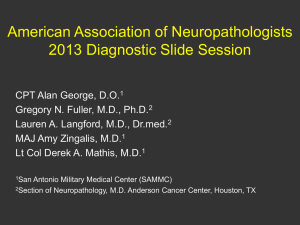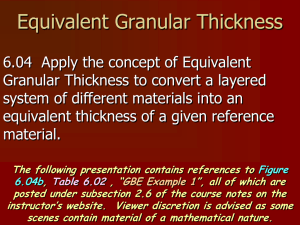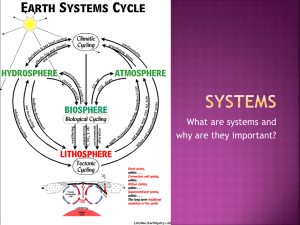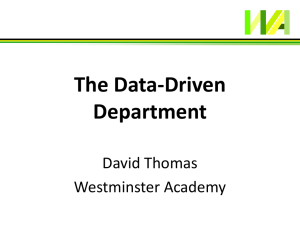reosato lecture 3 - applications
advertisement
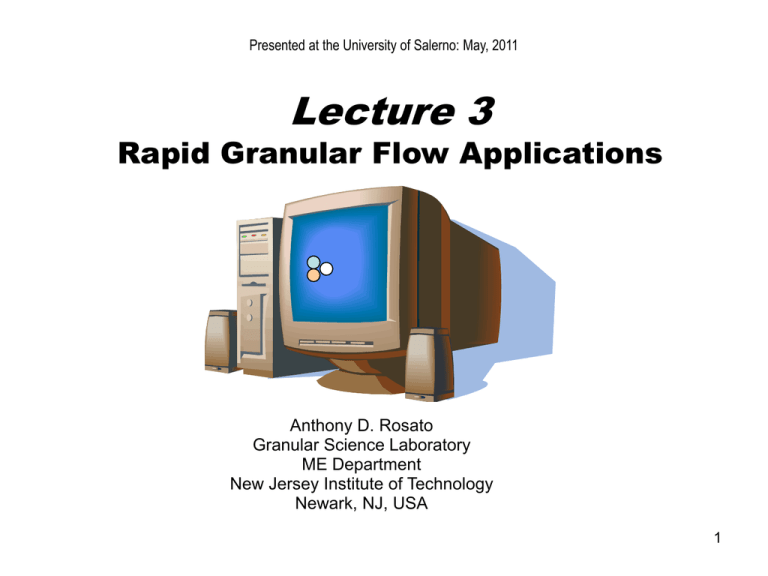
Presented at the University of Salerno: May, 2011 Lecture 3 Rapid Granular Flow Applications Anthony D. Rosato Granular Science Laboratory ME Department New Jersey Institute of Technology Newark, NJ, USA 1 Lecture 3: Rapid Granular Flow Applications Presentation Outline Application 1: Galton’s Board Application 2: Vibrated Systems Application 3: Couette Flows Application 4: Intruder Dynamics in Couette Flows Application 5: Density Relaxation -Continuous Vibrations Application 6: Tapped Density Relaxation Granular Science Lab - NJIT 2 Lecture 3: Rapid Granular Flow Applications Application 1: Galton’s Board Investigate the behavior of a single particle migrating under gravity through an ordered, planar array of rigid obstacles – a system known as a Galton’s board. Examine subtle connections between the deterministic particle simulations, physical experiments, and discrete dynamical models First step in a larger picture to extract generic dynamical features of granular flows through the analyses of “simple” models Granular Science Lab - NJIT 3 Lecture 3: Rapid Granular Flow Applications Historical Background Sir Francis Galton (1822 – 1911): British scientist, Fellow of the Royal Society; Geographer, meteorologist, tropical explorer, founder of differential psychology, inventor of fingerprint identification, pioneer of statistical correlation and regression, convinced hereditarian, eugenicist, protogeneticist, half-cousin of Charles Darwin and bestselling author. http://www.mugu.com/galton/start.html Developed “board” to describe biological processes statistically “I have no patience with the hypothesis occasionally expressed, and often implied, especially in tales written to teach children to be good, that babies are born pretty much alike, and that the sole agencies in creating differences between boy and boy, and man and man, are steady application and moral effort. It is in the most unqualified manner that I object to pretensions of natural equality. The experiences of the nursery, the school, the University, and of professional careers, are a chain of proofs to the contrary.” -- Francis Galton, Hereditary Genius Granular Science Lab - NJIT 4 Lecture 3: Rapid Granular Flow Applications Galton’s Board: EXPERIMENTS 5 16 5 32 1 dp 16 Rendering of the board depicting the pins, collection slots, traverse, location of the optical timer beams, and detail of the triangular lattice configuration of pins. Granular Science Lab - NJIT 5 Lecture 3: Rapid Granular Flow Applications Granular Science Lab - NJIT 6 Lecture 3: Rapid Granular Flow Applications Experimental Apparatus Schematic of the automatic Galton Board data acquisition system (AGB). Balls fed from the supply hopper through a flexible tube are dropped one at a time using a system of solenoids. The residence time is recorded via an optical sensor (“stop eye”). The exit position is also recorded with an array of 49 custom-built optical cell detectors. Granular Science Lab - NJIT 7 Lecture 3: Rapid Granular Flow Applications Experimental Parameters Materials of the sphere Aluminum Brass Stainless Steel Release Height Board Tilt Angle H (max = 15.53”) q (30o to 70o) – measured from horizontal Measurements Made Residence Times Distribution of Exit Positions Computed Quantities Average downward velocity (cm/sec) Lateral dispersion (cm2/sec) Granular Science Lab - NJIT 8 Lecture 3: Rapid Granular Flow Applications Sampling of Experimental Results Average residence time Tav as a function of release height H for stainless steel spheres. 12 Average Residence Time (sec) 11 10 9 Board Angle 8 Deg ree 7 0 7 Deg ree 6 0 6 Deg ree 5 0 5 Deg ree 4 0 4 Deg ree 3 0 3 2 1 0 5 10 15 20 25 30 35 40 Release Height (cm) Granular Science Lab - NJIT 9 Lecture 3: Rapid Granular Flow Applications Distribution of Exit Positions for Stainless Steel Spheres Granular Science Lab - NJIT 10 Lecture 3: Rapid Granular Flow Applications Lateral Dispersion or Diffusivity Diffusion model [Bridgwater et al., Trans. Instn. Chem. Engrs. 49, 163-169 (1971) ] c ( x, t ) - concentration of particles at (x, t) for an infinitely wide board o ( x ) - delta-distribution centered at x = 0 and height No c 2c D 2 , t 0, x t x lim c( x, t ) 0, t 0 x c( x,0) N o o ( x), x Solution … c ( x, t ) Granular Science Lab - NJIT No 2 πDt e x 2 4 Dt 11 Lecture 3: Rapid Granular Flow Applications N ( x, t ) - number of particles in the interval [-x, x] x 2 4 Dt z N ( x, t ) dz Noerf x 2 Dt e 2 Dt x No D = 1.85 cm2/sec Least squares fit of the stainless steel data (solid circles) to the model. Spheres were released from the top of the board set at q = 70o. The origin of the x-axis denotes the center of the board. Summary of Dispersion Results Granular Science Lab - NJIT 12 Lecture 3: Rapid Granular Flow Applications Sample Trajectories Generated by the Simulation Figure 9: Three typical trajectories from the discrete element simulation (q = 70o) obtained by slightly varying the initial positions. Residence times are indicated for each trajectory. The center of the board is located at X = 0.2032 meters. Granular Science Lab - NJIT 13 Lecture 3: Rapid Granular Flow Applications Simulated Exit Position Distribution Exit distribution of the number of particles for 1/8” spheres at board angle q = 70o from simulation in which e = 0.6 Granular Science Lab - NJIT 14 Lecture 3: Rapid Granular Flow Applications Lateral Dispersion Computed from Limiting Slope of Mean Square Displacement 1 D lim r 2 2.43 cm2 sec t 2t (m2) Granular Science Lab - NJIT 15 Lecture 3: Rapid Granular Flow Applications Comparison of Simulated Results with Experiments Quantity Tav (s) V (cm/s) D (cm2/s) Simulations (q = 70o) 7.12 5.6 2.43 Simulations (q = 90o) 6.70 5.92 1.48 Experiments (q = 70o) Stainless Steel 7.22 5.49 1.85 Aluminum 6.84 5.77 1.96 Brass 6.81 5.79 2.085 Granular Science Lab - NJIT 16 Lecture 3: Rapid Granular Flow Applications Application 2: Vibrated Systems Investigate macroscopic behavior of granular materials subjected to vibrations Gravitationally loaded into a rectangular, periodic cell having an open top and plan floor Vibrations imposed through sinusoidally oscillated floor Compare with kinetic theory predictions Compare with physical experiments Y. Lan, A. Rosato, “Macroscopic behavior of vibrating beds of smooth inelastic spheres, Phys. Fluids 7 [8], 1818 (1995) Granular Science Lab - NJIT 17 Lecture 3: Rapid Granular Flow Applications Geometry of Periodic Computational Cell Spheres are smooth (no friction) and inelastic, obeying the soft contact laws of Walton and Braun. Steady state computations performed. Simulation Parameters Granular Science Lab - NJIT 18 Lecture 3: Rapid Granular Flow Applications Steady-State Diagnostics In computing depth profiles, the cell is partitioned into layers of thickness equal to approximately the particle diameter d. Instantaneous layer diagnostic: Massweighted average taken over all particles that Averaging layer occupy the layer at time t. A layer is ‘identified’ by its center y-coordinate. y mt Nd 2 6 A Mass hold-up: bulk mass supported by the floor of cross-sectional area A N = # of spheres Long term cumulative mean velocity of layer-y taken over the time interval (to, t1). Instantaneous fluctuating (or deviatoric velocity) of the ith particle in layer-y L Granular Science Lab - NJIT Designates the long-term average 19 Lecture 3: Rapid Granular Flow Applications Depth profile of the instantaneous RMS deviatoric velocity Long-term cumulative, mass-weighted average deviatoric velocity depth profile T 1 C ( y, t ) L 2 3 W ( y) T ( y) / dg Granular Temperature depth profile Measure of the kinetic energy per unit mass attributed to the particles’ fluctuating velocity components. Non-dimensional Granular Temperature depth profile S. Ogawa, “Multi-temperature theory of granular materials”, Proceedings of the US-Japan Seminar on ContinuumMechanical and Statistical Approaches in the Mechanics of Granular Materials, Tokyo, 1978, pp. 208-217. Granular Science Lab - NJIT 20 Lecture 3: Rapid Granular Flow Applications Comparisons with Kinetic Theory of Richman and Martin Granular Science Lab - NJIT 21 Lecture 3: Rapid Granular Flow Applications Granular Science Lab - NJIT 22 Lecture 3: Rapid Granular Flow Applications Comparisons with Experiments of Hunt et al. Validation against Experiments Paper lid M. Hunt et al., J. Fluids Eng. 116, pg. 785 (1994). Relatively smooth spheres used in experiment 136 grams of particles used, mt = 5.0 asin(t ) Simulation Parameters Granular Science Lab - NJIT 23 Lecture 3: Rapid Granular Flow Applications Granular Science Lab - NJIT 24 Lecture 3: Rapid Granular Flow Applications Granular Science Lab - NJIT 25 Lecture 3: Rapid Granular Flow Applications Summary of Findings The behavior of the system depends on the magnitude of the floor acceleration G = a2/g High accelerations: Dense upper region supported on a ‘fluidized’ lower-density region near the floor Granular temperature is maximum near the floor and attenuates (upwards) towards the surface, and the solids fraction depth profiles peaks within the center of the system. Lower Accelerations: Granular temperature does not decrease monotonically from the floor, and the solids fraction depth profile bulges near the floor. Upper region of the system is highly agitated. For accelerations less than (approx.) 1.2, the steady-state height of the system remains constant. For 1.2 < G < 2.0: System undergoes a large vertical expansion. Computed steady-state granular temperature and solids fraction profiles in good agreement with kinetic theory predictions when the system is sufficiently agitated, and with physical experiments. Granular Science Lab - NJIT 26 Lecture 3: Rapid Granular Flow Applications Convection in a Vibrated Vessel of Granular Materials Rough, inelastic spheres obeying the Walton & Braun soft-particle models. Continuously shake the vessel up and down. Particles will flow upwards near the walls and downward in the center. Granular Science Lab - NJIT 27 Lecture 3: Rapid Granular Flow Applications Velocity Field – Long-time Average Superimposed Trajectory of Large Intruder Parameters m mb = 0.8, f = 7 Hz, a/d = 0.5, G = 10 Width = 20d Velocity Spheres Y. Lan and A. D. Rosato, Phys. Fluids 9 (12), 3615-3624 (1997). Granular Science Lab - NJIT 28 Lecture 3: Rapid Granular Flow Applications Granular Science Lab - NJIT 29 Lecture 3: Rapid Granular Flow Applications Average Convection Velocity as a Function of G 4.5 0.15 0.25 4 0.275 Avg. Cnv. Vel. (m/s x .01) 3.5 0.3 0.4 3 0.5 Poly. (0.15) 2.5 Poly. (0.25) Poly. (0.275) 2 Poly. (0.3) 1.5 Poly. (0.4) Poly. (0.5) 1 0.5 0 0 2 4 6 8 10 12 Gamma Granular Science Lab - NJIT 30 Lecture 3: Rapid Granular Flow Applications Long-term velocity field in a computational cell whose lateral walls are smooth (no friction). Notice the downward flow in the center and upward motion adjacent to the walls. Granular Science Lab - NJIT 31 Lecture 3: Rapid Granular Flow Applications Instantaneous velocity fields and sphere center projections for the 100d cell (f = 7 Hz, a/d = 0.5, G = 10) reveals the formation of arches during the downwards motion of the floor. The dashed line represents the equilibrium position of the floor. Although the arches are not very distinct in (b), the corresponding instantaneous velocity field reveals a pattern where groups of particles are moving collectively towards or away from the floor. This has been marked by the arrows in (c) whose directions indicate the general sense of the flow at a time subsequent to that shown in (b). Granular Science Lab - NJIT 32 Lecture 3: Rapid Granular Flow Applications Comparison of trajectory of large intruder in a narrow and wide cell. Notice the re-entrainment in (b), while the intruder is trapped at the surface in (a). Granular Science Lab - NJIT 33 Lecture 3: Rapid Granular Flow Applications Summary of Findings The onset of convection is controlled by (a/d)G rather than by G alone. When the lateral walls are frictional, a long-term convective flow develops that is upward in the center of the cell and downward adjacent to the walls. Reversal in the direction of the long-term convective flow occurs when the sidewalls are smooth. As the cell width (w/d) is increased, a visible pattern in the long-term velocity field is reduced and eventually it ceases to be evident. Over the time scale of the period of vibration, adjacent internal convection fields with opposed circulations were visible. Averaging over long time scales caused these flow structures not to appear. However, near the side walls, persistent vortex-like structures were attached, having a length scale that appeared to be of the same order as the height of the static system. A single, large intruder sphere placed on the floor in the center of the system was carried up to the surface at nearly the same velocity as the mean convection. Upon reaching the surface, it migrated toward the side-walls. There it was either trapped, or re-entrained into the bed, depending on the width of the downward flow field near the wall relative to the particle diameter. Granular Science Lab - NJIT 34 Lecture 3: Rapid Granular Flow Applications Application 3: Couette Flow Upper and lower bumpy walls move at constant velocity in opposite directions. Collisions with flow particles causes them to flow. Granular Science Lab - NJIT 35 Lecture 3: Rapid Granular Flow Applications General Features of the Flow - Steady-state Profiles - Velocity Granular Temperature Solids Fraction Pressure Granular Science Lab - NJIT 36 Lecture 3: Rapid Granular Flow Applications Steady State 0.8 Vxmean (d/s) 16.0 Y/d 12.0 8.0 4.0 1-top bdry 2 0.6 3 0.4 4 5 0.2 6 7 0.0 0.0 -0.4 -0.2 0.0 0.2 0.4 0 30 60 90 120 150 180 8-middle Average Number of Collisions V/U Average # of collisions/sec ~ 30 for each particle Granular Science Lab - NJIT 37 Lecture 3: Rapid Granular Flow Applications Granular temperature - kinetic energy of the velocity fluctuations 1 ' ' ' ' ' ' Tt u u v v w w 3 v vv v v ' Dimensionless “Peculiar” Velocity Particle Velocity Tt Tt (d )2 Effective shear rate = 2U/H Mean Velocity Granular Science Lab - NJIT 38 Lecture 3: Rapid Granular Flow Applications Granular Temperature Profiles Mean Velocity Profiles 1 0.9 1 0.8 0.9 0.7 0.8 0.5 H=16d 0.4 H=32d 0.3 Y/H Y/H 0.7 H=8d 0.6 0.6 n = 0.45 0.5 0.4 H=8d H=16d H=32d 0.3 0.2 0.2 0.1 0.1 0 -1 0 0 0.5 1 1.5 Tt Granular Science Lab - NJIT 2 2.5 3 -0.5 0 u 0.5 1 u U 39 Lecture 3: Rapid Granular Flow Applications Pressure - Pyy Solids Fraction Profiles 1 0.9 16 0.8 14 n bulk 0.45 0.7 12 10 Y/H Y /d 0.6 8 0.5 6 H=16d 0.4 4 H=32d 0.3 2 0.2 P * yy 0 0.1 0.3 0.5 0.7 0.9 0.1 1 N 1 N P P P mi ui ui rij Fij V i 1 2ij k 0 0 0.1 0.2 0.3 n Granular Science Lab - NJIT 0.4 0.5 0.6 40 Lecture 3: Rapid Granular Flow Applications Secondary Velocity Field (u( x, y), v ( x, y) ) U U = 8 d/s H/d = 8 2y/d 2 / s U x/d Slab used to compute v (x ) Averaging layer used for profiles H u(x, y ) y x Dy z Dx L Granular Science Lab - NJIT u(x, y ) u ( y ) U Dx 41 Lecture 3: Rapid Granular Flow Applications Velocity field for U = 8 d/s (W/d=64) v (x ) t (s) x/d Figure 7: Plot of v (x ) as a function of x/d (L/d = 64, 2 / s ) showing development to the steady state velocity. This appears in the inset, where the horizontal axis is 2x/d. Granular Science Lab - NJIT 42 Lecture 3: Rapid Granular Flow Applications v (x ) for U = 8 d/s (W/d=64) Auto-Correlation Peak at l = =15 R FFT spectrum analysis Peak at l = 7.5 d Granular Science Lab - NJIT 43 Lecture 3: Rapid Granular Flow Applications Wavelength vs. Effective Shear Rate 40 Wavelength (l/ d ) 35 30 25 20 15 10 5 0 0 0.5 1 1.5 2 2.5 Effective shear rate 3 3.5 4 4.5 Figure 8: Wavelength l/d of the convection cells as a function of effective shear rate for a fixed shear gap H/d = 8. The solid line is included to show the trend. Granular Science Lab - NJIT 44 Lecture 3: Rapid Granular Flow Applications Application 4: Intruder Dynamics in Couette Flows Intruder Properties • Different size, but same density • Different mass, but same size • Different size, same mass Granular Science Lab - NJIT -U 45 Lecture 3: Rapid Granular Flow Applications Size and Mass Ratios Size Ratio f = D/d Mass Ratio fm ~ f3 1 1.5 1 3.375 2 3 8 27 f = Intruder diameter/Flow particle diameter fm = Intruder mass/Flow particle mass Granular Science Lab - NJIT 46 Lecture 3: Rapid Granular Flow Applications Intruder Velocity and Mid-Plane Crossing Time 3.5 70 3 U = 32 r/s 2.5 Tc (s) U = 64 r/s U = 32 r/d 1.5 U=16 r/s 50 U = 16 r/s 2 Vav 60 U = 64 r/s U = 16 r/s 40 U=32 r/s 30 1 20 0.5 10 U=64 r/s 0 0 0.0 1.0 2.0 Size Ratio f 3.0 4.0 0 1 f 2 3 4 (a) Crossing time Tc (seconds) versus f at U = +/-16, 32, 64 r/s; (b) Average intruder velocity Vav S Tc , where S is the distance traveled by the mass center from its initial position near the wall to the mid-plane of the cell. Granular Science Lab - NJIT 47 Lecture 3: Rapid Granular Flow Applications Tc = Rise Time for the intruder to reach the middle layer from bottom. f= 1.0 f= 2.0 1 1 Tc=14 s 0.8 0.8 0.6 0.6 Y/H Y/H Tc=48 s 0.4 D / d = 2.0 0.4 0.2 0.2 D / d = 1.0 0 0 20 40 60 Time (s) 80 100 0 0 20 40 60 Time (s) 80 100 As the relative size of the intruder increase, its rise time decreases. Granular Science Lab - NJIT 48 Lecture 3: Rapid Granular Flow Applications Y* Trajectory + Power Spectrum (f =1.0) 2 / s 2 / s Y * (Y Ym (f)) /( H 2* Ym (f)) Ym(f) - Closest distance possible between the center of the intruder and boundary plane P( f ) 1 f Granular Science Lab - NJIT lg( P ) lg( f ) 49 Lecture 3: Rapid Granular Flow Applications Power spectrum of Intruder y-Trajectories f = D/d h = -(2h + 1) P f- 1.0 0.7 -2.4 P f -2.4 2.0 0.9 -2.8 P f -2.8 3.0 1.06 -3.06 P f -3.06 P( f ) 1 f lg( P ) lg( f ) Background: Noise Signals Granular Science Lab - NJIT 50 Lecture 3: Rapid Granular Flow Applications General Information on Noise = 0 White noise = 1 1/f noise (often in processes found in nature) = 2 Brownian noise (random walk) Granular Science Lab - NJIT 51 Lecture 3: Rapid Granular Flow Applications 1 P( f ) f Pf 1 f 2h1 h = ½, Brownian Motion, h is Hausdorff (or Hurst) exponent. h <1/2, anti-persistence fBm (fractional Brownian motion), trend of motion at any time t is not likely to be followed by a similar trend at next moment t+1. h >1/2, persistence fBm (fractional Brownian motion), trend of motion at any time t is likely to be followed by a similar trend at next moment t+1. f=1.0 h=0.7, Granular Science Lab - NJIT f=2.0 h=0.9, f=3.0 h=1.06 52 Lecture 3: Rapid Granular Flow Applications Intruder Histograms of its y-location 1.0 1.0 0.8 0.8 D / d =1.5 0.6 Y/H Y/H D / d =1.0 0.4 0.6 0.4 0.2 0.2 0.0 0.0 0 0.01 f = 1.0 0.02 0.03 Frequency Granular Science Lab - NJIT 0.04 0.05 0 0.01 f = 1.5: 0.02 0.03 Frequency 0.04 0.05 53 Lecture 3: Rapid Granular Flow Applications Intruder Histograms - Continued 1.0 1.0 0.8 0.8 0.6 D / d =3.0 Y/H Y/H D / d =2.0 0.4 0.6 0.4 0.2 0.2 0.0 0.0 0 0.01 f =2.0 0.02 0.03 Frequency 0.04 0.05 0 0.01 f =3.0 0.02 0.03 Frequency 0.04 0.05 “Trapping” in region of low granular temperature S. Dahl, C. Hrenya, Physics of Fluids 16, 1-24 (2004). Granular Science Lab - NJIT 54 Lecture 3: Rapid Granular Flow Applications Net resultant force averaged over time interval D ZONE +U Fy (t )net 1 2 Y 1 Nc j Fy N c (t ) j 1 3 4 5 Fx 6 X D is three orders of magnitude smaller than time scale over which the dynamics evolve, but much larger than the integration step. 7 Fy Fne t Normalized Fy (t ) 8 9 10 ( Fy (t )net d2U H ) 2 -U Granular Science Lab - NJIT 55 Lecture 3: Rapid Granular Flow Applications Evolution of Fy and Vy Fy Vy Fy Vy Figure 13: Evolution of Fy (t ) for (a) f = 1, (c) f = 3, and velocity V y (t ) for (b) f = 1 and (d) f = 3. Granular Science Lab - NJIT 56 Lecture 3: Rapid Granular Flow Applications Root-mean-square force and Velocity versus f 0.50 0.25 F y rms = 0.0772 f + 0.0114 0.40 0.20 R 2 = 0.9931 V yrms (F y) rms 0.30 0.15 0.10 0.30 V y rms = 0.2023f-1.2731 0.20 R 2 = 0.9925 0.10 0.05 0.00 0.00 0 1 f 0 2 3 1 f 2 3 Figure 14: Steady state graphs of Fyrms (left) and V yrms (right) versus size f. Correlation coefficients R2 are shown for each fitted curve. Granular Science Lab - NJIT 57 Lecture 3: Rapid Granular Flow Applications How does particle mass affect the fluctuation velocity in the direction perpendicular to the shear? Procedure: Vary particle density and maintain size ratio f = 1 f = Intruder diameter / flow particle diameter fm = Mass Intruder / Mass of flow particles Vyrms ( d / s ) n = 0.45 = constant 3.0 Original System: Vary size ratio f and maintain constant particle density . 2.0 1.0 0.0 0.5 1.0 1.5 Granular Science Lab - NJIT f 2.0 2.5 3.0 58 Vyrms ( d / s ) Lecture 3: Rapid Granular Flow Applications 3.0 f=1 2.0 Vary mass ratio fm and maintain size ratio f. 1.0 0.0 Vyrms ( d / s ) 0 5 fm 10 15 3.0 Vary size ratio f and maintain mass ratio fm. 2.0 fm = 1 1.0 0.0 0.0 1.0 Granular Science Lab - NJIT f 2.0 3.0 59 Lecture 3: Rapid Granular Flow Applications Progression of Velocity Distributions for f = 1 f m=8.0 Hist(Vy) 1500 1000 f m=27.0 f m=3.375 f m=1.0 500 f m=0.5 0 -6 -4 -2 0 2 4 6 V yrms ( d / s ) An increase in particle mass results in a narrower velocity distribution (qualitative agreement with the Maxwell-Boltzmann distribution). Granular Science Lab - NJIT 60 Lecture 3: Rapid Granular Flow Applications Application 5: Density Relaxation Under Continuous Vibrations • After exposure to vibrations or taps, a bulk solid can attain an increase in density. This phenomenon is often referred to as “density relaxation” or “densification”. • Its occurrence depends on the behavior induced in the material, which in turn is influenced by particle properties, vessel geometry and wall conditions, strength of the vibrations, and the initial or “poured” state of the material. • The importance of understanding densification is pertinent to solids handling industries in which vibrations are often used to enhance the processing of large quantities of bulk materials. • Density relaxation’s historical background can be traced in the literature on the packing of spheres and disks (Appendix L3-A) Granular Science Lab - NJIT 61 Lecture 3: Rapid Granular Flow Applications Densification Experiments: Uniform Spheres Acrylic spheres: d = 1/8″ Cylinder = 1200 kg/m3 Controller Frequency: 25 – 100 Hz Shake r Amplitude (a/d): 0.04 – 0.24 Amplifier Accelerometer Aspect Ratio: D/d ~ 20 “Maximum” Solids Fraction: Power Amplifier G: 0.94 – 11.0 (relative acceleration) T = 10 minutes (vibration duration) n = 0.6366 ± 0.0005 for uniform spheres G.D.Scott, D.M.Kilgour, British Journal of Applied Physics,1969. D. J. D’Appolonia, and E. D’Apolonia, Proc.3rd Asian Reg. Conf. on Soil Mechanics, 1266~1268, Jerusalem Academic Press (1967). R. Dobry and R. V. Whitman, “Compaction of Sand …”, ASTM STP 523, 156~170, ASTM, Philadelphia (1973). Granular Science Lab - NJIT Details → 62 Lecture 3: Rapid Granular Flow Applications Details of the Experimental Procedure … Compute bulk solids fraction and improvement in solids fraction. d = 0.125 inch Pour Slice Improvement in Solids Fraction = Granular Science Lab - NJIT Vibrate Solids Fraction n relaxed 1 100 n poured 63 Lecture 3: Rapid Granular Flow Applications Results: Systems vibrated for 10 minutes 2 2 3 4 0.635 a/d=0.04 4.5 Solids Fraction 4 3.5 0.625 3 0.62 2.5 2 0.615 1.5 1 0.61 2 3 2 4 6 4 8 5 8 a/d=0.06 5 0.625 3 0.62 2 0.615 1 0 0 0.6 2 3 4 5 6 7 8 Relative Acceleration 10 0.64 12 4.5 4 0.628 3.5 0.624 3 0.62 2.5 2 0.616 1.5 0.612 3 4 5 6 a/d=0.24 5 0.63 4 Solids Fraction 5 2 0.635 Improvement in Solids Fraction (%) a/d=0.16 0.632 Solids Fraction 7 0.605 5.5 0.636 6 0.61 Relative Acceleration 0.64 5 4 0.5 0.605 1 4 0.63 Solids Fraction 5 Improvement in Solids Fraction (%) 5.5 0.635 0.63 3 5 Improvement in Solids Fraction (%) 1 0.625 3 0.62 2 0.615 1 0.61 Improvement in Solids Fraction (%) 0.64 1 0.608 0.605 2 4 6 8 Relative Acceleration 10 12 2 3 4 5 6 0 Relative Acceleration Data points are averages of 4 trials Granular Science Lab - NJIT 64 Lecture 3: Rapid Granular Flow Applications Do Simulations Results Agree with Physical Experiments ? Y L Comparisons: Poured Bulk Density W Vibrated Bulk Density H d x Z z Vibrating Floor Averaging Layer Some Background …. 1944: Oman & Watson [Natl. Patrol. News 36, R795-R802 (1944)] coined the terms random “random dense” and “random loose” to describe the two limiting cases of random, uniform sphere packings. 1960: Scott carried out a number of different experiments with 3mm steel ball bearings to study dense & loose random packings … Spherical containers and N steel ball bearing: He plotted packing fraction n vs. system size and extrapolated … n-loose = 0.59 n-dense = 0.63 1969: G.D.Scott, D.M.Kilgour, British Journal of Applied Physics n = 0.6366 ± 0.0005 for uniform spheres 1997: E. R. Nowak, M. Povinelli, et al., Powders & Grains 97, (Balkema, Durham, NC, 1997), pp. 377 - 380. n = 0.656 for vibrated column (d/D ~ 9) of uniform spheres Select literature: Sphere packing Granular Science Lab - NJIT 65 Lecture 3: Rapid Granular Flow Applications Select Literature on Packing of Spheres Coord. No. System Solids Fraction Reference 0.601 0.001/ 0.637 0.001 Steel spheres in cylinder 0.625 Steel spheres in glass container McGeary (1961) 0.6366 0.004 0.59 Steel spheres in cylinder Finney Computer Tory, et al. (1968) 0.628 Computer Adams & Matheson (1972) 6.0 0.61 Computer Bennett (1972) 6.4 0.582 Computer Visscher & Bolsterli (1972) 6.01 0.58 Computer Tory, Church, et al. (1973) 6.0 Computer Matheson (1974) 6.0 0.606 0.006 0.6099 / 0.6472 Statistical Model Gotoh & Finney (1974) 6.0 6.0 0.59 0.01 0.58 0.05 Computer Powell (1980) Computer Rodriguez, et al. (1986) 0.634 Computer Mason (1967) 0.582 Computer 0.6366 Computer Gotoh, Jodrey & Tory (1978) Jodrey & Tory (1981) 0.610 – 0.658 Computer Zhang & Rosato (2004) 6.1 5.64 Granular Science Lab - NJIT Scott (1960) 66 Lecture 3: Rapid Granular Flow Applications Extrapolated solids fraction for infinitely wide container in good agreement with experiments reported in literature. 0.61 0.05 0.1 0.15 0 0.62 Solids Fraction 0.6 0.59 0.01 0.2 0.02 0.03 0.25 0.04 0.62 0.615 0.615 0.61 0.61 0.605 0.605 0.6 0 0.01 0.02 0.03 0.04 0.61 0.6 0.59 0.6 0.58 0.58 0.57 0.57 n = 0.6102 0.56 0.55 0.05 0.1 0.15 0.56 0.2 0.25 0.55 Aspect Ratio d/L Solids fraction as a function of the inverse aspect ratio (d/L) for a system of particles with friction coefficient m = 0.1. The inset shows the extrapolated value 0.6102 as d/L → 0. n depends on m → Granular Science Lab - NJIT 67 Lecture 3: Rapid Granular Flow Applications Particles that are more frictional produce a less dense structure after pouring because of formation of bridges among particles. As m increases, there is approximately a 7% reduction in n. At m = 0, the solids fraction is within the range of values normally ascribed for a loose or poured random packing of smooth spheres, i.e., approximately between 0.59 to 0.608. Solids Fraction 0.6 0 0.2 0.4 0.6 0.8 0.6 0.59 0.59 0.58 0.58 0.57 0.57 0.56 0.56 0.55 0 0.2 0.4 0.6 0.8 0.55 Friction Coefficient Variation of the solids fraction with friction coefficient m (d/L = 0.1064, N = 600). Each point of the curve represents an average taken over 10 realizations, while the bars show the deviation. Granular Science Lab - NJIT 68 Lecture 3: Rapid Granular Flow Applications Simulated Random Dense Packing 40 50 60 70 80 90 110 a=0.01' ' a=0.02' ' a=0.03' ' a=0.04' ' a=0.06' ' a=0.005' ' 0.635 0.63 Solids Fraction 100 0.635 0.63 0.625 0.625 0.62 0.62 0.615 0.615 0.61 30 40 50 60 70 80 90 100 110 0.66 120 0.64 0.61 120 Solids Fraction 30 0.64 Simulated Trends 5 10 15 0.66 0.655 0.655 0.65 0.65 0.645 0.645 0.64 0.64 0.635 0.635 0.63 0.63 0.625 0.625 0.62 0.62 0.615 0.615 0.61 0.61 0 Frequency (Hz) 5 10 15 Vibration Time(s) 0 0.01 0.02 0.03 0.04 0.05 0.06 0.07 0.08 0.09 0.1 0.67 Solids Fraction n = 0.6582 is the solids fraction of random dense packing, in good agreement with the experimental result of Nowak et al. (0.656) 0 0.11 0.67 0.668 0.668 0.666 0.666 0.664 0.664 0.662 0.662 0.66 0.66 0.658 0.658 0.656 0.656 0.654 0 0.01 0.02 0.03 0.04 0.05 0.06 0.07 0.08 0.09 0.1 0.654 0.11 1/Tv Granular Science Lab - NJIT 69 Lecture 3: Rapid Granular Flow Applications Simulated Trends versus Frequency …. 50 75 0.612 5.5 Solids Fraction 4 3.5 0.595 3 2.5 0.59 2 1.5 0.585 50 70 80 90 5.5 5 0.606 0.604 4.5 0.602 4 0.6 0.598 a/d=0.08 3.5 0.596 3 0.58 30 40 50 60 70 80 1 0.594 0.5 90 0.592 30 40 50 0 20 40 60 70 80 2.5 90 Frequency(Hz) Frequency(Hz) 0.615 60 0.608 Solids Fraction a/d=0.02 0.6 Improvement in Solids Fraction(%) 4.5 40 0.61 5 0.605 30 Improvement in Solids Fraction(%) 25 0.61 60 80 30 0.588 40 50 60 70 80 90 6 0.595 3 0.59 2 a/d=0.24 0.585 1 0.58 0 a/d=0.48 1 0.582 0.5 0.58 0.578 0 0.576 -0.5 0.574 0.572 -1 0.575 -1 0.57 0 20 40 Frequency(Hz) Granular Science Lab - NJIT 60 80 Improvement in Solids Fraction (%) 4 0.584 Solids Fraction 0.6 Improvement in Solids Fraction(%) 5 0.605 Solids Fraction 1.5 0.586 0.61 0.57 30 40 50 60 70 80 90 Frequency(Hz) 72 Lecture 3: Rapid Granular Flow Applications Simulated Densification Phase Map: L/d = 25, N = 8000 0.459431 1.39462 2.32982 3.26501 4.20021 0.12 0.11 0.1 Amplitude (inch) 0.09 0.08 0.07 0.06 0.05 0.04 0.03 0.02 0.01 20 Granular Science Lab - NJIT 40 60 Frequency (Hz) 80 73 Lecture 3: Rapid Granular Flow Applications Experimental Evidence L. Vanel, A. Rosato, R. Dave, Phys. Rev. Lett. 78, 1255 (1997). Cylinder Controller Shaker Amplifier Accelerometer Power Amplifier Small amplitudes a/d < 0.25, and high frequencies (40 – 80 Hz) Granular Science Lab - NJIT 74 Lecture 3: Rapid Granular Flow Applications Application 6: Density Relaxation under Tapping Taps applied Rearrangement of particle positions so that the bulk density of the material increases. System is compacted “Package sold by weight, not volume. Contents may settle during shipment.” Granular Science Lab - NJIT 75 Lecture 3: Rapid Granular Flow Applications The study of density relaxation has its foundations in the extensive literature on the packing of circles and spheres 1611: 1665: 1694: 1727: 1887: 1899: 1932: 1933: 1944: 1951: Kepler - Geometry of the snowflake Robert Hook - Circle and sphere packings Gregory, a Scottish astronomer, suggested that 13 rigid uniform spheres could be packed around a sphere of the same size Hales - Packing of dry peas pressed into a container Thompson - How to fill Euclidean space using truncated octahedrons Slichter – Found analytical expressions for the porosity in beds of uniform spheres Hilbert - Found a structure for which nm=0.123 Heesch and Laves: Created a stable arrangement of spheres with nm= 0.056 Oman & Watson: ‘Loose’ and ‘dense’ random packing of spheres Stewart - Consolidated state of optimal bulk density Much more … Boyd, D. W. "The Residual Set Dimension of the Apollonian Packing." Mathematika 20, 170-174, 1973. Granular Science Lab - NJIT Apollonian Gasket 76 Lecture 3: Rapid Granular Flow Applications OBJECTIVE: Model the behavior of tapped a system of particles to understand its evolution from a loose, disordered configuration to a dense structure exhibiting order. Parameters for discrete element simulation Number of particles: 3,456 d=0.02m Periodic BC in lateral dimensions Particle material density = 1.2 g/cm3 Restitution coefficient e = 0.9 Particle-particle friction mp=0.1 Integration Time step ~ 10-5 s Granular Science Lab - NJIT 77 Lecture 3: Rapid Granular Flow Applications Simulation Procedure Randomly place spheres (diameter d) into the periodic volume Turn on gravity – spheres collapse to a loose, random structure (pour) Apply discrete tap of amplitude a/d and frequency f. Allow system to relax until quiescent. Kinetic Energy ~ 0 System tapped Particles bounce back a/d = 0.4; f = 7.5 Hz Granular Science Lab - NJIT 78 Lecture 3: Rapid Granular Flow Applications Animation of Pouring from DEM Simulation Granular Science Lab - NJIT 79 Lecture 3: Rapid Granular Flow Applications Tapping Sequence: Motion of the Plane Floor ( ) a sin 2 f t t p ( i 1) tC , t i tC t p ; i tC y0 (t ) 0, otherwise tC t p tb , t p relaxation time, tb tapping time Granular Science Lab - NJIT Dimensionless acceleration a 2 a G 4 2 f 2 1.35 g g 80 Lecture 3: Rapid Granular Flow Applications System Response to Taps The vertical positions of particles in a given layer (yi/d) after tap are monitored Granular Science Lab - NJIT 81 Lecture 3: Rapid Granular Flow Applications Simulated Effect of Particle Friction m on Poured Bulk Solids Fraction Particle that are more frictional produce a less dense structure after pouring because of formation of bridges among particles. Data points are averages over 20 realizations. Red lines are error bars. McGeary (1961): Steel spheres in glass cylinder Granular Science Lab - NJIT 82 Lecture 3: Rapid Granular Flow Applications Sample Realizations n o 0.6118 n o 0.6110 n f 0.6884 n f 0.7018 n o 0.6116 Average n f 0.7007 Granular Science Lab - NJIT of 20 realizations n o 0.6118 n f 0.7077 83 Lecture 3: Rapid Granular Flow Applications Distribution of Particle Centers Number of particle centers inside a layer of thickness H normalized by the total number of system particles Poured System Ordering adjacent to plane floor Granular Science Lab - NJIT 84 Lecture 3: Rapid Granular Flow Applications Center Distribution averaged over 10 consecutive taps Granular Science Lab - NJIT 85 Lecture 3: Rapid Granular Flow Applications Ensemble-Averaged Center Distribution f 7.5 Hz a / d 0.44 G 0.5 Granular Science Lab - NJIT 86 Lecture 3: Rapid Granular Flow Applications Evidence of a Critical Displacement Amplitude Monte Carlo simulation results strongly suggest that there is a critical displacement amplitude g that promotes an optimal evolution to a dense structure. Before Tap MC Simulated Tap Applied g g O.Dybenko, A. Rosato, V. Ratnaswamy, D. Horntrop, L. Kondic, “Density Relaxation by Tapping”, in preparation. Granular Science Lab - NJIT Although not presented here, similar findings were observed in DEM simulations. 87 Lecture 3: Rapid Granular Flow Applications Evolution of Structure: Effect of Displacement Amplitude f 7.5 Hz a / d 0.11 G 0.5 Granular Science Lab - NJIT 88 Lecture 3: Rapid Granular Flow Applications Evolution of Structure: Effect of Displacement Amplitude f 7.5 Hz a / d 0.44 G 0.5 Granular Science Lab - NJIT 89 Lecture 3: Rapid Granular Flow Applications Summary - Conclusions The parameter space of factors affecting the process is large: tap amplitude, frequency, acceleration, particle properties, mass overburden, container aspect ratio Four time scales: particle collision duration (Dt ~ 10-5 s), period of applied tap, single-tap system relaxation time, long-time relaxation scale Discrete element model reveals the mechanism… Upward progression of “organized” layers induced by the plane floor as the taps evolve. The configuration of the particles plays an important role in how the system evolves, rather than solely the value of the bulk solids fraction. Evidence of a critical tap intensity that optimizes the evolution of packing density. Granular Science Lab - NJIT 90 Lecture 3: Rapid Granular Flow Applications End of Lecture 3 Granular Science Lab - NJIT 91 Lecture 3: Rapid Granular Flow Applications Appendix L3-A: Selected Highlights on Packing Studies 1611 Kepler [1]: Interested in the geometry of the snowflake 1665 Hooke [2]: Studied the packing of circles and spheres 1727 Hales [3]: A botanist who carried out an experimental investigation of the packing of dry peas pressed in a container – forming fairly regular polyhedra, which he erroneously assumed were regular dodecahedra. The experiment is known as the “peas of Buffon” (based on similar experiments done by Comte de Buffon in 1753). 1694 Gregory [1]: Hypothesizes that 13 rigid uniform spheres can be packed around another sphere of the same size. (Newton’s conjecture was 12) 1963 Proved that adequate space for 13.397 spheres exists around a single sphere, BUT this arrangement is impossible (1956, Leech [7]). 1939 Marvin [2]: Repeated Hales’ experiment by applying pressure on uniform lead shot Close-packed initial configuration particles formed into regular dodecahedron (12 faces, each a rhombus) Randomly poured initial configuration predominant structure was irregular 14-faced polyhedra, and no rhombic dodecahedra. 1883 Barlow [8]: Found hexagonal close packing where each sphere touches 12 others. [1] Scottish astronomer (1661-1708) [2] Also by Matzke [5] Granular Science Lab - NJIT Rhombic Dodecahedron 12 faces 92 Lecture 3: Rapid Granular Flow Applications Appendix L3-A: Selected Highlights on Packing Studies 1887 Thompson: How to fill Euclidean space without voids can be done using truncated octahedral (14 faces = 6 squares + 8 hexagons) 1899 Slichter: Studied porosity and channels in bed of uniform spheres. 1st attempt to find analytical expressions. “Practical Issue” - How dense can uniform spheres be packed? 1958 Rogers [11]: If there was a regular arrangement of uniform spheres more dense than that of a hexagonal close packing (), it’s packing fraction could be no larger than 1 18 cos (1/ 3) ( 3) 0.7797 Alternative: What is the minimal solids fraction of rigid assembly of uniform spheres? Rigidity Each sphere must touch at least 4 others, and the points of contact must not lie all in one plane. 1932 Hilbert [12] found “loosest” packing with n = 0.123 1933 Heesch & Laves [13] found looser packing with n = 0.056. 1944: Oman & Watson * coined the terms random “random dense” and “random loose” to describe the two limiting cases of random, uniform sphere packings. * A. O. Oman & K. M. Watson, “Pressure drops in granular beds,” Natl. Patrol. News 36, R795-R802 (1944). Granular Science Lab - NJIT 93 Lecture 3: Rapid Granular Flow Applications Appendix L3-A: Selected Highlights on Packing Studies 1960: Scott carried out a number of different experiments with 3mm steel ball bearings to study dense & loose random packings … Spherical containers and N steel ball bearing: He plotted packing fraction n vs. 1 3 N and extrapolated to large N. nloose 0.59 ndense 0.63 Pouring into cylindrical containers followed by 2 minutes of shaking to obtain dense random packing Cylinder rotated about horizontal axis to obtain loose random packing. Studies were also carried out in cylinders of various heights. 1969: Scott* carried out improved experiments for the solids fraction of a dense random packing. ndense 0.6366 0.0005 * G. D. Scott and D. M. Kilgour, “The density of random close packing of spheres,” Brit. J. Appl. Phys. (J. Phys. D) 2, 863-866 (1969). Granular Science Lab - NJIT 94 Lecture 3: Rapid Granular Flow Applications Appendix L3-A: Selected Highlights on Packing Studies Random Loose Packing of Spheres Experiments: G. Onoda and Y. Liniger, PRL 64, 2727, 1990 0.6 Packing Fraction 0.58 0.56 0.54 0.52 0.5 0 0.005 0.01 0.015 0.02 1/N Granular Science Lab - NJIT 95 Lecture 3: Rapid Granular Flow Applications Appendix L3-A: Selected Literature on Packing Studies References for Additional Reading 1.J. A. Dodds, “Simplest statistical geometric model of the simplest version of the multicomponent random packing problem,” Nature, Vol. 267, 187-189 (1975). 2.W. A. Gray, The packing of solid particles, Chapman & Hall, London (1968). 3.D. N. Sutherland, “Random packing of circles in a plane,” Journal of Colloidal and Interface Science 60 [1], 96-102 (1977). 4.T. G. Owe Berg, R. I. McDonald, R. J. Trainor, Jr., “The packing of spheres,” Powder Technol. 3, 183-188 (1969/70). 5.C. Poirier, M. Ammi, D. Bideau, J.P. Troadec, “Experimental study of the geometrical effects in the localization of deformation,” Phys. Rev. Lett. 68 [2], 216-219 (1992). 6.D. R. Nelson, M. Rubinstein, F. Spaepen, “Order in two-dimensional binary random array,” Philosophical Magazine A 46 [1], 105-126 (1982). 7.A. Gervois, D. Bideau, “Some geometrical properties of hard disk packings,” in Disorder and Granular Media (ed. D. Bideau), Elsevier/North Holland (1992). 8.F. Deylon, Y.E. Lévy, “Instability in 2D random gravitational packings of identical hard discs,” J. Phys. A: Math Gen. 23, 4471-4480 (1990). 9.G. C. Barker, M. J. Grimson, “Sequential random close packing of binary disc mixtures,” J. Phys. Condens. Matter 1, 2279-2789 (1989). 10.D. Bideau, J. P. Troadec, “Compacity and mean coordination number of dense packings of hard discs,” J. Phys. C: Solid State Phys. 17, L731-L735 (1984). 11.M. Ammi, T. Travers, D. Bideau, Y. Delugeard, J. C. Messager, J. P. Troadec, A. Gervois, “Role of angular correlations on the mechanical properties of 2D packings of cylinders,” J. Phys.: Condens. Matter 2, 9523-9530 (1990). 12.T. I. Quickenden and G. K. Tan, “Random packing in two dimensions and the structure of monolayers,” Journal of Colloidal and Interface Science 48 [3], 382-393 (1974). 13.G. Mason, “Computer simulation of hard disc packings of varying packing density,” Journal of Colloidal and Interface Science 56 [3], 483-491( 1976). 14.J. Lemaitre, J. P. Troadec, A. Gevois, D. Bideau, “Experimental study of densification of disc assemblies,” Europhys. Lett 14 [1], 77-83 (1991). 15.H. H. Kausch, D. G. Fesko, N. W. Tshoegl, “The random packing of circles in a plane,” Journal of Colloidal and Interface Science 37 [3], 603-611 (1971). 16.Y. Ueharra, T. Ree, F. H. Ree, “Radial distribution function for hard disks from the BGY2 theory,” J. Chem. Phys. 70, 1877-1883 (1979). 17.H. Stillinger, E. A. DiMarzio, R. L. Kornegay, ,”Systematic approach to explanation of the rigid disk phase transition,” J. Chem. Phys. 40[6], 1564-1576 (1964). 18.J. V. Sanders, “Close-packed structure of spheres of two different sizes I. Observations on natural opal,” Philosophical Magazine A 42 [6], 705-720 (1980). 19.E. Guyon, S. Roux, A. Hansen, D. Bideau, J-P. Troadec, H. Crapo, “Non-local and non-linear problems in the mechanics of disordered systems: application to granular media and rigidity problem,” Rep. Prog. Phys. 53, 373-419 (1996). 20.W. M. Visscher, M. Bolsterli, “Random packing of equal and unequal spheres in two and three dimensions,” Nature 239, pg. 504 (1972). 21.J. G. Berryman, “Random close packing of hard spheres and disks,” Phys. Rev. A 27 [2], 1053-1061 (1983). 22.M. Shahinpoor, “Statistical mechanical considerations on the random packing of granular materials,” Powder Technol. 25, 163-176 (1980). 23.M. J. Powell, “Computer-simulated random packing of spheres,” Powder Technol. 25, 45-42 (1980). 24.L. Oger, J. P. Troadec, D. Bideau, J. A. Dodds, M.J. Powell, “Properties of disordered sphere packings, I. geometric structure: statistical model, numerical simulations and experimental results,” Powder Technol. 45, 121-131 (1986). A. P. Shapiro, R. F. Probstein, “Random packings of spheres and fluidity limits of monodisperse and bidisperse suspensions,” Phys. Rev. Lett 68 [9], 1422-1425 (1992). Granular Science Lab - NJIT 96 Lecture 3: Rapid Granular Flow Applications Appendix L3-A: Selected Literature on Packing Studies G. T. Nolan, P. E. Kavanagh, “Computer simulation of random packings of spheres with log-normal distributions,” Powder Technol. 76, 309-316 (1993). N. Standish, D. E. Borger, “The porosity of particulate mixtures,” Powder Technol. 22, 121-125 (1979). T. Stovall, F. De Larrard, M. Buil, “Linear packing density model of grain mixtures,” Powder Technol. 48, 1-12 (1986). A. B. Yu, N. Standish, “An analytical-parametric theory of the random packing of particles,” Powder Technol. 55, 171-186 (1988). A. B. Yu, N. Standish, “A study of the packing of particles with a mixture size distribution,” Powder Technol. 76, 112-124 (1993). M. Gardner, “Circles and spheres, and how they kiss and pack,” Scientific American 218 [5], 130-134 (1968). H. J. Frost, “Cavities in dense random packings,” Acta Metall. 30, 889-904 (1982). S. K. Chan, K. M. Ng, “Geometrical characteristics of the pore space in a random packing of equal spheres,” Powder Technology 54, 147-155 (1988). K. Gotoh, S. Jodrey, E. M. Tory, “Average nearest-neighbor spacing in a random dispersion of equal spheres,” Powder Technol. 21, 285-287 (1978). M. J. Powell, “Distribution of near neighbours in randomly packed hard spheres,” Powder Technol. 26, 221-223 (1980). A. Marmur, “ A thermodynamic approach to the packing of particle mixtures,” Powder Technol. 44, 249-253 (1985). A. E. R. Westman and H. R. Hugill, “The packing of particles,” J. Am. Ceram. Soc. 13 [10], 767-779 (1930). A.E.R. Westman, “The packing of particles: empirical equations for intermediate diameter ratios,” J. Am. Ceram. Soc. 19, 127-129 (1936). S. Yerazunis, J. W. Bartlett, A. H. Nissa, “Packing of binary mixtures of spheres and irregular particles,” Nature 195, 33-35 (1962). S. Yerazunis, S. W. Cornell, B. Wintner, “Dense random packing of binary mixtures of spheres, Nature 207, 835-837 (1965). D. J. Lee, “Packing of spheres and its effects on the viscosity of suspensions,” J. Paint Technol. 42 [550], 579-587 (1970). T. C. Powers, “Geometric properties of particles and aggregates,” Journal of the Portland Cement Association 6 [1], 2-15 (1964). D. J. Adams & A. J. Matheson, “Computation of dense random packing of hard spheres,” J. Chem. Phys. 56, 1989-1994 (1972). C. H. Bennett, “Serially deposited amorphous aggregates of hard spheres,” J. Appl. Phys. 6, 2727-2733 (1972). J. L. Finney, “Random packing and the structure of simple liquids. 1. The geometry of random close packing,” Proc. Roy. Soc. Lond. A. 319, 479-493 (1970). K. Gotoh & J. L. Finney, “Statistical geometrical approach to random packing density of equal spheres,” Nature 252, 202-205 (1974). K. Gotoh, W. S. Jodrey & E. M. Tory, “A random packing structure of equal spheres – statistical geometrical analysis of tetrahedral configurations,” Powder Technol. 20, 233-242 (1978). W. S. Jodrey & E. M. Tory, “Computer simulation of isotropic, homogeneous, dense random packing of equal spheres,” Powder Technol. 30, 111-118 (1981). R. K. McGeary, “Mechanical packing of spherical particles,” J. Am. Ceram. Soc. 44, 513-522 (1961). G. Mason, “General discussion,” Discus. Faraday Soc. 43, 75-88 (1967). A. J. Matheson, “Computation of a random packing of hard spheres,” J. Phys. 7, 2569-2576 (1974). M. J. Powell, “Computer-simulated random packing of spheres,” Powder Technol. 25, 45-52 (1980). J. Rodriquez, C. H. Allibert & J. M. Chaix, “A computer method for random packing of spheres of unequal size,” Powder Technol. 47, 25-33 (1986). G.D. Scott, “Packing of spheres,” Nature 188, 908-909 (1960). E.M. Tory, B. H. Church, M.K. Tam & M. Ratner, “Simulation random packing of equal spheres,” Can. J. Chem. Eng. 51, 484-493 (1973). E.M. Tory, N. A. Cochrane & S.R. Waddell, “Anisotropy in simulated random packing of equal spheres,” Nature 220, 1023-1024 (1968). W.M. Visscher & M. Bolsterli, “Random packing of equal and unequal spheres in two and three dimensions,” Nature 239, 504-507 (1972). Granular Science Lab - NJIT 97 Lecture 3: Rapid Granular Flow Applications Appendix L3-B: Basic Terminology on Packing Vb : = Bulk volume Vp : = Volume of particles rp = Particle density e = Fractional voidage (void fraction) (1) A = Voids ratio (2) eA = Fractional Free Area = Ratio of the free area in a plane parallel to the layers in regular packing to the total area of the plane n = Solids fraction = Vp/Vb (3) b = Bulk density = Weight of the particles/Vb = pVp/Vb Substitute Vp = Vb(1-e) obtained from (1) into the above … b = p (1 - e) Vs = Apparent specific volume 1 1 p (1 e) b (4) (5) The void ratio e can be expressed in terms of e as follows: Substitute Vb/Vp = 1/(1 - e) obtained from (1) into (2) 1 e 1 1 e 1 e Granular Science Lab - NJIT (6) 98
